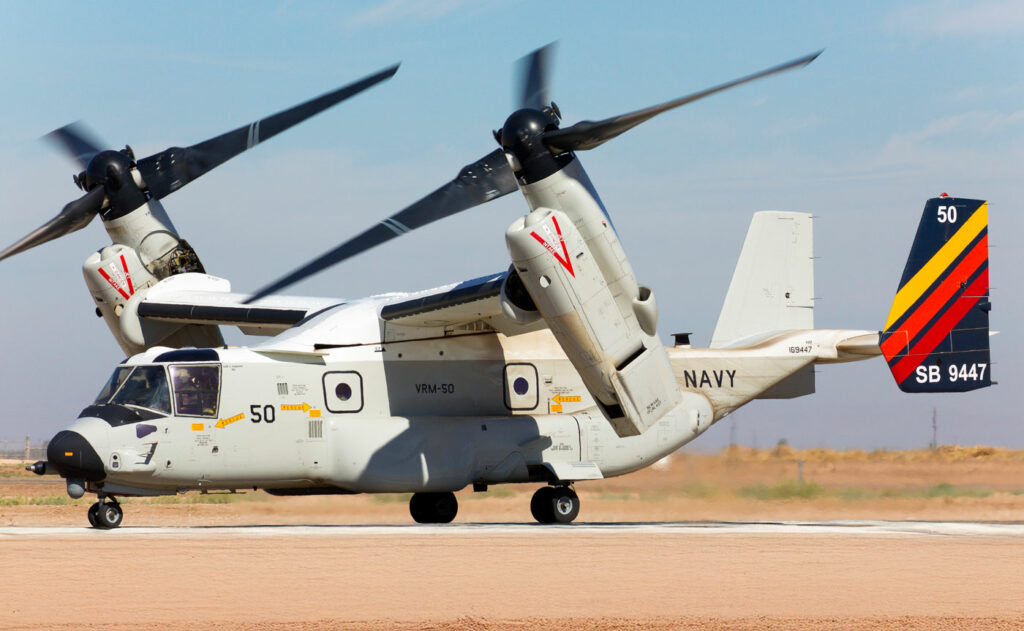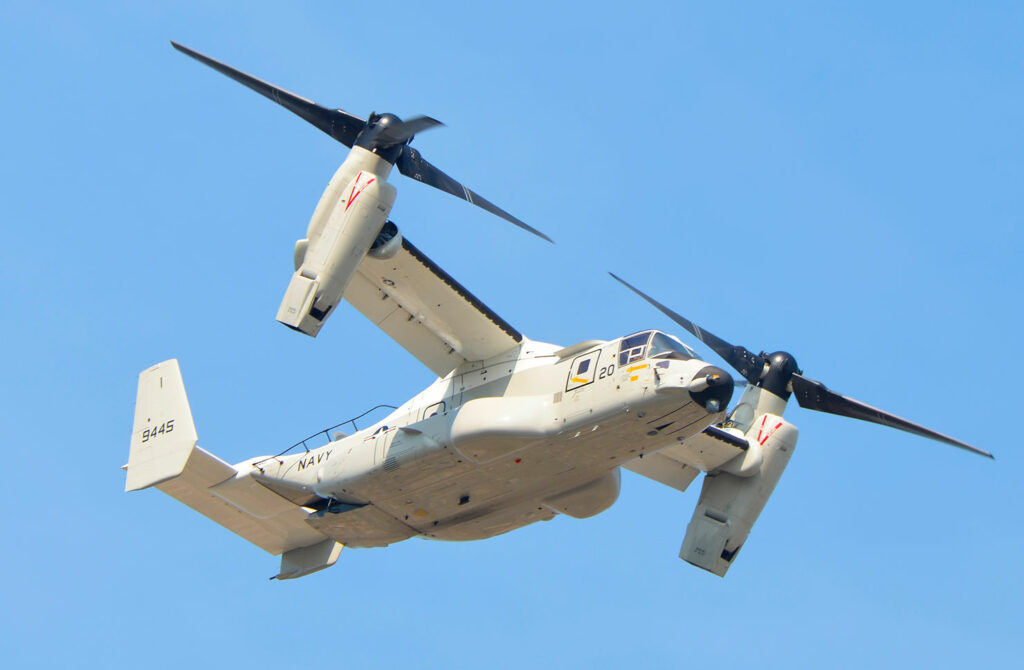The Bell Boeing CMV-22B Osprey is a U.S. Navy tiltrotor aircraft designed for carrier onboard delivery, combining vertical takeoff with fixed-wing flight.
The Bell Boeing CMV-22B Osprey is a tiltrotor aircraft developed for the U.S. Navy’s carrier onboard delivery (COD) missions. It features vertical takeoff and landing (VTOL) capabilities like a helicopter, combined with the speed and range of a fixed-wing aircraft. Powered by two Rolls-Royce AE1107C Liberty turboshaft engines, each producing 6,150 shaft horsepower (4,586 kW), the CMV-22B achieves a maximum speed of 275 knots (316 mph or 509 km/h) and a range of approximately 1,150 nautical miles (1,320 miles or 2,130 km). Its design includes a wingspan of 45 feet 10 inches (14 meters) and a length of 57 feet 4 inches (17.5 meters). The aircraft can transport up to 6,000 pounds (2,722 kg) of cargo or personnel, making it a versatile asset for logistics support. Enhancements over previous variants include extended fuel tanks for increased range and a beyond-line-of-sight communication system, enabling seamless integration into carrier strike group operations.
History of the Development of the Bell Boeing CMV-22B Osprey
In the early 21st century, the U.S. Navy recognized the need to replace its aging fleet of C-2A Greyhound aircraft, which had served as the primary carrier onboard delivery (COD) platform since the mid-1960s. The C-2A’s limited range and payload capacity, along with the increasing maintenance challenges of an aging airframe, underscored the necessity for a more capable and versatile replacement.
The Navy sought an aircraft that could not only match but exceed the capabilities of the C-2A, with requirements including extended range, increased payload capacity, and the ability to operate from aircraft carriers without the need for catapult launches or arresting gear. Additionally, the evolving nature of naval operations demanded a platform capable of rapid and flexible response to a variety of logistical challenges.
In response to these requirements, the Navy turned to the V-22 Osprey platform, developed jointly by Bell Helicopter and Boeing. The V-22’s tiltrotor design, which allows for vertical takeoff and landing (VTOL) as well as high-speed, long-range horizontal flight, made it a strong candidate for the COD role. The Marine Corps had already been operating the MV-22B variant successfully, demonstrating the platform’s versatility and reliability in various operational scenarios.
The Navy initiated the CMV-22B program to develop a variant of the V-22 tailored specifically for COD missions. Key objectives included extending the aircraft’s range to meet the Navy’s operational requirements, integrating advanced communication systems for seamless connectivity within carrier strike groups, and modifying the cargo bay to accommodate the Navy’s unique logistical needs.
Development of the CMV-22B involved close collaboration between the Navy, Bell Helicopter, and Boeing. The program focused on incorporating lessons learned from the Marine Corps’ experience with the MV-22B, while also addressing the specific demands of naval operations. This included enhancing the aircraft’s fuel capacity to achieve a range of approximately 1,150 nautical miles (1,320 miles or 2,130 km), sufficient to support long-distance logistics missions.
The CMV-22B’s design also featured a beyond-line-of-sight communication system, enabling real-time data exchange and coordination with carrier strike groups over extended distances. Additionally, the cargo bay was configured to transport the F-35C Lightning II engine power module, a critical requirement as the Navy began integrating the F-35C into its carrier air wings.
The first flight of the CMV-22B took place on December 19, 2019, marking a significant milestone in the program’s development. Subsequent testing focused on validating the aircraft’s performance, including its range, payload capacity, and compatibility with carrier operations. The Navy conducted a series of sea trials to assess the CMV-22B’s ability to operate from aircraft carriers, including takeoffs, landings, and deck handling procedures.
In February 2021, the Navy announced that the CMV-22B had achieved Initial Operational Capability (IOC), signifying that the aircraft was ready for deployment in support of fleet operations. The CMV-22B began replacing the C-2A Greyhound, with the transition expected to enhance the Navy’s logistical capabilities significantly.
The CMV-22B’s introduction represents a transformative shift in the Navy’s approach to carrier onboard delivery. Its ability to deliver personnel, equipment, and supplies directly to the flight deck without the need for catapult launches or arresting gear increases operational flexibility and reduces the time required for critical logistics missions.
Furthermore, the CMV-22B’s extended range and speed enable it to support a broader spectrum of missions, including humanitarian assistance, search and rescue, and special operations support. Its versatility and advanced capabilities position the CMV-22B as a cornerstone of the Navy’s future air logistics strategy.
The development of the CMV-22B Osprey underscores the Navy’s commitment to leveraging advanced technologies to enhance operational readiness and support its global mission. By replacing the venerable C-2A Greyhound with a more capable and versatile platform, the Navy is ensuring that its carrier strike groups have the logistical support necessary to maintain a decisive edge in a rapidly evolving security environment.

Design of the Bell Boeing CMV-22B Osprey
The Bell Boeing CMV-22B Osprey is designed to fulfill the U.S. Navy’s carrier onboard delivery (COD) requirements. Its innovative tiltrotor design combines the vertical takeoff and landing (VTOL) capabilities of a helicopter with the speed and range of a turboprop airplane.
Tiltrotor Mechanism and Airframe Design
- Tiltrotor Configuration: The CMV-22B is equipped with two three-bladed proprotors mounted on nacelles at the wingtips. The nacelles rotate to allow the aircraft to transition between vertical and horizontal flight modes.
- Airframe: The aircraft has a length of 57 feet 4 inches (17.5 meters), a wingspan of 45 feet 10 inches (14 meters) when folded, and an extended wingspan of 84 feet 7 inches (25.8 meters) during flight. Its compact folding wing design allows for storage on crowded aircraft carrier decks.
- Materials: The airframe is constructed using advanced composite materials to reduce weight while maintaining structural integrity.
Cargo and Payload Capabilities
- Cargo Bay: The CMV-22B features a spacious cargo bay capable of accommodating a wide range of payloads, including the F-35C engine power module, an essential component for supporting the Navy’s fifth-generation fighters.
- Payload Capacity: The aircraft can carry up to 6,000 pounds (2,722 kg) of cargo or transport up to 24 personnel in its cabin, making it versatile for logistical and personnel transport missions.
Fuel and Range Enhancements
- The CMV-22B incorporates extended-range fuel tanks, allowing it to achieve a range of approximately 1,150 nautical miles (2,130 km) without refueling. This enhancement ensures the aircraft can operate over long distances, meeting the Navy’s requirements for remote carrier strike groups.
Avionics and Communication Systems
- Beyond-Line-of-Sight Communication: The CMV-22B is equipped with advanced communication systems that enable seamless data exchange between the aircraft and carrier strike group commanders, even at extended ranges.
- Cockpit: The aircraft features a fully digital cockpit with redundant systems for increased reliability in combat and non-combat environments.
Folding Mechanism
- The CMV-22B incorporates a folding wing and rotor mechanism, enabling the aircraft to operate on aircraft carriers with limited deck space. The nacelles rotate upward, and the wings fold along the fuselage to minimize its footprint.
Advantages and Drawbacks
Advantages:
- Flexibility: Combines VTOL capabilities with high-speed horizontal flight, making it adaptable to diverse missions.
- Extended Range: Enhanced fuel capacity significantly increases its operational reach.
- Versatility: Capable of transporting both cargo and personnel, including large payloads like the F-35C engine power module.
Drawbacks:
- Operational Complexity: The tiltrotor design requires rigorous maintenance and advanced training for operators.
- Noise: The proprotors produce significant noise, which may affect operations in stealth or sensitive environments.
The design innovations in the CMV-22B make it a critical component of the U.S. Navy’s logistical operations, enhancing the ability to support carrier strike groups worldwide.
Performance of the Bell Boeing CMV-22B Osprey
The Bell Boeing CMV-22B Osprey delivers high performance, combining the unique capabilities of a helicopter and a turboprop airplane. Its design ensures reliable and efficient operations in demanding naval environments.
Engine and Power
- The CMV-22B is powered by two Rolls-Royce AE1107C Liberty turboshaft engines, each capable of producing 6,150 shaft horsepower (4,586 kW).
- The engines are mounted in rotating nacelles at the wingtips, allowing the proprotors to transition between vertical lift and horizontal thrust.
Speed and Flight Characteristics
- Maximum Speed: The aircraft can achieve a maximum speed of 275 knots (316 mph or 509 km/h) in horizontal flight.
- Cruising Speed: It cruises efficiently at approximately 241 knots (277 mph or 446 km/h), balancing speed with fuel economy.
Range and Endurance
- Range: With extended fuel tanks, the CMV-22B offers a maximum range of 1,150 nautical miles (1,320 miles or 2,130 km). This range enables the aircraft to support carrier operations over vast distances.
- Endurance: The aircraft can remain airborne for extended periods, supporting sustained logistical and operational missions.
Operational Altitude
- The CMV-22B operates effectively at altitudes of up to 25,000 feet (7,620 meters), providing flexibility for high-altitude transit.
Payload and Cargo
- The CMV-22B can transport up to 6,000 pounds (2,722 kg) of cargo or carry 24 fully equipped personnel. Its interior layout is designed to maximize space while accommodating a variety of payloads.
Comparison to Competitors
- Compared to the C-2A Greyhound, the CMV-22B offers superior range, speed, and VTOL capabilities, eliminating the need for catapult launches and arresting gear.
- The tiltrotor design provides an advantage over traditional fixed-wing aircraft, allowing the CMV-22B to operate in confined spaces and austere environments.
Performance in Naval Operations
- The CMV-22B’s ability to deliver high-value cargo, such as the F-35C engine module, directly to aircraft carriers enhances its utility in critical naval missions.
- Its speed and range allow it to support rapid response operations, including medical evacuations and humanitarian aid delivery.
The CMV-22B’s performance metrics highlight its role as a versatile and efficient platform for carrier-based logistics and support missions.

Variants of the Bell Boeing CMV-22B Osprey
The CMV-22B is part of the V-22 Osprey family, which includes several variants tailored for different branches of the U.S. military:
- MV-22B Osprey (USMC):
- Primary variant for the U.S. Marine Corps.
- Used for assault support, troop transport, and medevac missions.
- Features mid-air refueling capabilities and a smaller fuel capacity than the CMV-22B.
- CV-22B Osprey (USAF):
- Specialized for the U.S. Air Force.
- Designed for long-range special operations missions, including infiltration and extraction in hostile environments.
- Equipped with advanced avionics for night and adverse-weather operations.
- CMV-22B Osprey (USN):
- Tailored for the U.S. Navy’s COD missions.
- Features extended fuel tanks, increased range, and advanced communications systems.
- Cargo bay optimized for transporting large payloads, such as the F-35C engine module.
These variants reflect the adaptability of the V-22 platform, with the CMV-22B uniquely positioned to support naval operations.
The Bell Boeing CMV-22B Osprey is a transformative addition to the U.S. Navy’s logistical capabilities. By integrating vertical takeoff and landing with long-range, high-speed performance, it addresses the Navy’s evolving operational needs. Its ability to deliver critical cargo, personnel, and equipment directly to carrier decks ensures its value in modern naval warfare. With advanced technology and a versatile design, the CMV-22B sets a new standard for carrier onboard delivery platforms.
Back to Transport planes.